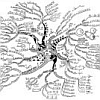| |
  
Gabriel Cardona,
Francesc Rosselló and
Gabriel Valiente. Tripartitions do not always discriminate phylogenetic networks. In MBIO, Vol. 211(2):356-370, 2008.
Keywords: distance between networks, phylogenetic network, phylogeny, Program Bio PhyloNetwork, tree-child network, tripartition distance.
Note: http://arxiv.org/abs/0707.2376, slides available at http://www.newton.cam.ac.uk/webseminars/pg+ws/2007/plg/plgw01/0904/valiente/.
Toggle abstract
"Phylogenetic networks are a generalization of phylogenetic trees that allow for the representation of non-treelike evolutionary events, like recombination, hybridization, or lateral gene transfer. In a recent series of papers devoted to the study of reconstructibility of phylogenetic networks, Moret, Nakhleh, Warnow and collaborators introduced the so-called tripartition metric for phylogenetic networks. In this paper we show that, in fact, this tripartition metric does not satisfy the separation axiom of distances (zero distance means isomorphism, or, in a more relaxed version, zero distance means indistinguishability in some specific sense) in any of the subclasses of phylogenetic networks where it is claimed to do so. We also present a subclass of phylogenetic networks whose members can be singled out by means of their sets of tripartitions (or even clusters), and hence where the latter can be used to define a meaningful metric. © 2007 Elsevier Inc. All rights reserved."
|
|
| |
|
| |
       
Bernard M. E. Moret,
Luay Nakhleh,
Tandy Warnow,
C. Randal Linder,
Anna Tholse,
Anneke Padolina,
Jerry Sun and
Ruth Timme. Phylogenetic Networks: Modeling, Reconstructibility, and Accuracy. In TCBB, Vol. 1(1):13-23, 2004.
Keywords: distance between networks, evaluation, phylogenetic network, phylogeny, time consistent network, tripartition distance.
Note: http://www.cs.rice.edu/~nakhleh/Papers/tcbb04.pdf.
|
|
| |
  
Cam Thach Nguyen,
Nguyen Bao Nguyen and
Wing-Kin Sung. Fast Algorithms for computing the Tripartition-based Distance between Phylogenetic Networks. In JCO, Vol. 13(3), 2007.
Keywords: distance between networks, phylogenetic network, phylogeny, tripartition distance.
Note: http://dx.doi.org/10.1007/s10878-006-9025-5.
Toggle abstract
"Consider two phylogenetic networks N and N′ of size n. The tripartition-based distance finds the proportion of tripartitions which are not shared by N and N′. This distance is proposed by Moret et al. (2004) and is a generalization of Robinson-Foulds distance, which is orginally used to compare two phylogenetic trees. This paper gives an O(min {kn log n, n log n + hn} -time algorithm to compute this distance, where h is the number of hybrid nodes in N and N′ while k is the maximum number of hybrid nodes among all biconnected components in N and N′. Note that k ≪ h ≪ n in a phylogenetic network. In addition, we propose algorithms for comparing galled-trees, which are an important, biological meaningful special case of phylogenetic network. We give an O(n)-time algorithm for comparing two galled-trees. We also give an O(n + kh)-time algorithm for comparing a galled-tree with another general network, where h and k are the number of hybrid nodes in the latter network and its biggest biconnected component respectively. © Springer Science+Business Media, LLC 2007."
|
|
| |
  
Gabriel Cardona,
Francesc Rosselló and
Gabriel Valiente. A Perl Package and an Alignment Tool for Phylogenetic Networks. In BMCB, Vol. 9:175, 2008.
Keywords: distance between networks, phylogenetic network, phylogeny, Program Bio PhyloNetwork, tree sibling network, tree-child network.
Note: http://dx.doi.org/10.1186/1471-2105-9-175.
Toggle abstract
"Background: Phylogenetic networks are a generalization of phylogenetic trees that allow for the representation of evolutionary events acting at the population level, like recombination between genes, hybridization between lineages, and lateral gene transfer. While most phylogenetics tools implement a wide range of algorithms on phylogenetic trees, there exist only a few applications to work with phylogenetic networks, none of which are open-source libraries, and they do not allow for the comparative analysis of phylogenetic networks by computing distances between them or aligning them. Results: In order to improve this situation, we have developed a Perl package that relies on the BioPerl bundle and implements many algorithms on phylogenetic networks. We have also developed a Java applet that makes use of the aforementioned Perl package and allows the user to make simple experiments with phylogenetic networks without having to develop a program or Perl script by him or herself. Conclusion: The Perl package is available as part of the BioPerl bundle, and can also be downloaded. A web-based application is also available (see availability and requirements). The Perl package includes full documentation of all its features. © 2008 Cardona et al; licensee BioMed Central Ltd."
|
|
| |

Luay Nakhleh. A Metric on the Space of Reduced Phylogenetic Networks. In TCBB, Vol. 7(2), 2010.
Keywords: distance between networks, phylogenetic network, phylogeny.
Note: http://www.cs.rice.edu/~nakhleh/Papers/tcbb-Metric.pdf.
Toggle abstract
"Phylogenetic networks are leaf-labeled, rooted, acyclic, and directed graphs that are used to model reticulate evolutionary histories. Several measures for quantifying the topological dissimilarity between two phylogenetic networks have been devised, each of which was proven to be a metric on certain restricted classes of phylogenetic networks. A biologically motivated class of phylogenetic networks, namely, reduced phylogenetic networks, was recently introduced. None of the existing measures is a metric on the space of reduced phylogenetic networks. In this paper, we provide a metric on the space of reduced phylogenetic networks that is computable in time polynomial in the size of the networks. © 2006 IEEE."
|
|
| |
  
Steven M. Woolley,
David Posada and
Keith A. Crandall. A Comparison of Phylogenetic Network Methods Using Computer Simulation. In PLoS ONE, Vol. 3(4):e1913, 2008.
Keywords: abstract network, distance between networks, evaluation, median network, MedianJoining, minimum spanning network, NeighborNet, parsimony, phylogenetic network, phylogeny, Program Arlequin, Program CombineTrees, Program Network, Program SHRUB, Program SplitsTree, Program TCS, split decomposition.
Note: http://dx.doi.org/10.1371/journal.pone.0001913.
Toggle abstract
"Background: We present a series of simulation studies that explore the relative performance of several phylogenetic network approaches (statistical parsimony, split decomposition, union of maximum parsimony trees, neighbor-net, simulated history recombination upper bound, median-joining, reduced median joining and minimum spanning network) compared to standard tree approaches (neighbor-joining and maximum parsimony) in the presence and absence of recombination. Principal Findings: In the absence of recombination, all methods recovered the correct topology and branch lengths nearly all of the time when the subtitution rate was low, except for minimum spanning networks, which did considerably worse. At a higher substitution rate, maximum parsimony and union of maximum parsimony trees were the most accurate. With recombination, the ability to infer the correct topology was halved for all methods and no method could accurately estimate branch lengths. Conclusions: Our results highlight the need for more accurate phylogenetic network methods and the importance of detecting and accounting for recombination in phylogenetic studies. Furthermore, we provide useful information for choosing a network algorithm and a framework in which to evaluate improvements to existing methods and novel algorithms developed in the future. © 2008 Woolley et al."
|
|
| |
   
Gabriel Cardona,
Mercè Llabrés,
Francesc Rosselló and
Gabriel Valiente. A Distance Metric for a Class of Tree-Sibling Phylogenetic Networks. In BIO, Vol. 24(13):1481-1488, 2008.
Keywords: distance between networks, phylogenetic network, phylogeny, polynomial, tree sibling network.
Note: http://dx.doi.org/10.1093/bioinformatics/btn231.
Toggle abstract
"Motivation: The presence of reticulate evolutionary events in phylogenies turn phylogenetic trees into phylogenetic networks. These events imply in particular that there may exist multiple evolutionary paths from a non-extant species to an extant one, and this multiplicity makes the comparison of phylogenetic networks much more difficult than the comparison of phylogenetic trees. In fact, all attempts to define a sound distance measure on the class of all phylogenetic networks have failed so far. Thus, the only practical solutions have been either the use of rough estimates of similarity (based on comparison of the trees embedded in the networks), or narrowing the class of phylogenetic networks to a certain class where such a distance is known and can be efficiently computed. The first approach has the problem that one may identify two networks as equivalent, when they are not; the second one has the drawback that there may not exist algorithms to reconstruct such networks from biological sequences. Results: We present in this articlea distance measure on the class of semi-binary tree-sibling time consistent phylogenetic networks, which generalize tree-child time consistent phylogenetic networks, and thus also galled-trees. The practical interest of this distance measure is 2-fold: it can be computed in polynomial time by means of simple algorithms, and there also exist polynomial-time algorithms for reconstructing networks of this class from DNA sequence data. © 2008 The Author(s)."
|
|
| |
   
Gabriel Cardona,
Mercè Llabrés,
Francesc Rosselló and
Gabriel Valiente. Metrics for phylogenetic networks I: Generalizations of the Robinson-Foulds metric. In TCBB, Vol. 6(1):46-61, 2009.
Keywords: distance between networks, explicit network, phylogenetic network, phylogeny, time consistent network, tree-child network, tripartition distance.
Note: http://dx.doi.org/10.1109/TCBB.2008.70.
Toggle abstract
"The assessment of phylogenetic network reconstruction methods requires the ability to compare phylogenetic networks. This is the first in a series of papers devoted to the analysis and comparison of metrics for tree-child time consistent phylogenetic networks on the same set of taxa. In this paper, we study three metrics that have already been introduced in the literature: the Robinson-Foulds distance, the tripartitions distance and the $mu$-distance. They generalize to networks the classical Robinson-Foulds or partition distance for phylogenetic trees. We analyze the behavior of these metrics by studying their least and largest values and when they achieve them. As a by-product of this study, we obtain tight bounds on the size of a tree-child time consistent phylogenetic network. © 2006 IEEE."
|
|
| |
   
Gabriel Cardona,
Mercè Llabrés,
Francesc Rosselló and
Gabriel Valiente. Metrics for phylogenetic networks II: Nodal and triplets metrics. In TCBB, Vol. 6(3):454-469, 2009.
Keywords: distance between networks, phylogenetic network, phylogeny.
Note: http://dx.doi.org/10.1109/TCBB.2008.127.
Toggle abstract
"The assessment of phylogenetic network reconstruction methods requires the ability to compare phylogenetic networks. This is the second in a series of papers devoted to the analysis and comparison of metrics for tree-child time consistent phylogenetic networks on the same set of taxa. In this paper, we generalize to phylogenetic networks two metrics that have already been introduced in the literature for phylogenetic trees: the nodal distance and the triplets distance. We prove that they are metrics on any class of tree- child time consistent phylogenetic networks on the same set of taxa, as well as some basic properties for them. To prove these results, we introduce a reduction/expansion procedure that can be used not only to establish properties of tree-child time consistent phylogenetic networks by induction, but also to generate all tree-child time consistent phylogenetic networks with a given number of leaves. © 2009 IEEE."
|
|
| |
   
Gabriel Cardona,
Mercè Llabrés,
Francesc Rosselló and
Gabriel Valiente. Path lengths in tree-child time consistent hybridization networks. In Information Sciences, Vol. 180(3):366-383, 2010.
Keywords: distance between networks, phylogenetic network, phylogeny, time consistent network, tree-child network.
Note: http://arxiv.org/abs/0807.0087?context=cs.CE.
Toggle abstract
"Hybridization networks are representations of evolutionary histories that allow for the inclusion of reticulate events like recombinations, hybridizations, or lateral gene transfers. The recent growth in the number of hybridization network reconstruction algorithms has led to an increasing interest in the definition of metrics for their comparison that can be used to assess the accuracy or robustness of these methods. In this paper we establish some basic results that make it possible the generalization to tree-child time consistent (TCTC) hybridization networks of some of the oldest known metrics for phylogenetic trees: those based on the comparison of the vectors of path lengths between leaves. More specifically, we associate to each hybridization network a suitably defined vector of 'splitted' path lengths between its leaves, and we prove that if two TCTC hybridization networks have the same such vectors, then they must be isomorphic. Thus, comparing these vectors by means of a metric for real-valued vectors defines a metric for TCTC hybridization networks. We also consider the case of fully resolved hybridization networks, where we prove that simpler, 'non-splitted' vectors can be used. © 2009 Elsevier Inc. All rights reserved."
|
|
| |
   
Gabriel Cardona,
Mercè Llabrés,
Francesc Rosselló and
Gabriel Valiente. On Nakhleh's metric for reduced phylogenetic networks. In TCBB, Vol. 6(4):629-638, 2009.
Keywords: distance between networks, phylogenetic network, phylogeny.
Note: Preliminary versions: http://arxiv.org/abs/0809.0110 and http://arxiv.org/abs/0801.2354v1.
Toggle abstract
"We prove that Nakhleh's metric for reduced phylogenetic networks is also a metric on the classes of tree-child phylogenetic networks, semibinary tree-sibling time consistent phylogenetic networks, and multilabeled phylogenetic trees. We also prove that it separates distinguishable phylogenetic networks. In this way, it becomes the strongest dissimilarity measure for phylogenetic networks available so far. Furthermore, we propose a generalization of that metric that separates arbitrary phylogenetic networks. © 2009 IEEE."
|
|
| |
   
Gabriel Cardona,
Mercè Llabrés,
Francesc Rosselló and
Gabriel Valiente. The comparison of tree-sibling time consistent phylogenetic networks is graph-isomorphism complete. In The Scientific World Journal, Vol. 2014(254279):1-6, 2014.
Keywords: abstract network, distance between networks, from network, isomorphism, phylogenetic network, tree sibling network.
Note: http://arxiv.org/abs/0902.4640.
Toggle abstract
"Several polynomial time computable metrics on the class of semibinary tree-sibling time consistent phylogenetic networks are available in the literature; in particular, the problem of deciding if two networks of this kind are isomorphic is in P. In this paper, we show that if we remove the semibinarity condition, then the problem becomes much harder. More precisely, we prove that the isomorphism problem for generic tree-sibling time consistent phylogenetic networks is polynomially equivalent to the graph isomorphism problem. Since the latter is believed not to belong to P, the chances are that it is impossible to define a metric on the class of all tree-sibling time consistent phylogenetic networks that can be computed in polynomial time. © 2014 Gabriel Cardona et al."
|
|
| |
|
| |
    
Bonnie Kirkpatrick,
Yakir Reshef,
Hilary Finucane,
Haitao Jiang,
Binhai Zhu and
Richard M. Karp. Comparing Pedigree Graphs. In JCB, Vol. 19(9):998-1014, 2012.
Keywords: distance between networks, from network, pedigree.
Note: http://arxiv.org/abs/1009.0909, preliminary version as poster at WABI 2010.
Toggle abstract
"Pedigree graphs, or family trees, are typically constructed by an expensive process of examining genealogical records to determine which pairs of individuals are parent and child. New methods to automate this process take as input genetic data from a set of extant individuals and reconstruct ancestral individuals. There is a great need to evaluate the quality of these methods by comparing the estimated pedigree to the true pedigree. In this article, we consider two main pedigree comparison problems. The first is the pedigree isomorphism problem, for which we present a linear-time algorithm for leaf-labeled pedigrees. The second is the pedigree edit distance problem, for which we present (1) several algorithms that are fast and exact in various special cases, and (2) a general, randomized heuristic algorithm. In the negative direction, we first prove that the pedigree isomorphism problem is as hard as the general graph isomorphism problem, and that the sub-pedigree isomorphism problem is NP-hard. We then show that the pedigree edit distance problem is APX-hard in general and NP-hard on leaf-labeled pedigrees. We use simulated pedigrees to compare our edit-distance algorithms to each other as well as to a branch-and-bound algorithm that always finds an optimal solution. © 2012, Mary Ann Liebert, Inc."
|
|
| |
    
Tetsuo Asano,
Jesper Jansson,
Kunihiko Sadakane,
Ryuhei Uehara and
Gabriel Valiente. Faster computation of the Robinson–Foulds distance between phylogenetic networks. In Information Sciences, Vol. 197:77-90, 2012.
Keywords: distance between networks, explicit network, level k phylogenetic network, phylogenetic network, polynomial, spread.
Toggle abstract
"The Robinson-Foulds distance, a widely used metric for comparing phylogenetic trees, has recently been generalized to phylogenetic networks. Given two phylogenetic networks N 1, N 2 with n leaf labels and at most m nodes and e edges each, the Robinson-Foulds distance measures the number of clusters of descendant leaves not shared by N 1 and N 2. The fastest known algorithm for computing the Robinson-Foulds distance between N 1 and N 2 runs in O(me) time. In this paper, we improve the time complexity to O(ne/log n) for general phylogenetic networks and O(nm/log n) for general phylogenetic networks with bounded degree (assuming the word RAM model with a word length of ⌈logn⌉ bits), and to optimal O(m) time for leaf-outerplanar networks as well as optimal O(n) time for level-1 phylogenetic networks (that is, galled-trees). We also introduce the natural concept of the minimum spread of a phylogenetic network and show how the running time of our new algorithm depends on this parameter. As an example, we prove that the minimum spread of a level-k network is at most k + 1, which implies that for one level-1 and one level-k phylogenetic network, our algorithm runs in O((k + 1)e) time. © 2012 Elsevier Inc. All rights reserved."
|
|
| |
 
Jesper Jansson and
Andrzej Lingas. Computing the rooted triplet distance between galled trees by counting triangles. In Journal of Discrete Algorithms, Vol. 25:66-78, 2014.
Keywords: distance between networks, explicit network, from network, galled network, phylogenetic network, phylogeny, polynomial, triplet distance.
Toggle abstract
"We consider a generalization of the rooted triplet distance between two phylogenetic trees to two phylogenetic networks. We show that if each of the two given phylogenetic networks is a so-called galled tree with n leaves then the rooted triplet distance can be computed in o(n2.687) time. Our upper bound is obtained by reducing the problem of computing the rooted triplet distance between two galled trees to that of counting monochromatic and almost-monochromatic triangles in an undirected, edge-colored graph. To count different types of colored triangles in a graph efficiently, we extend an existing technique based on matrix multiplication and obtain several new algorithmic results that may be of independent interest: (i) the number of triangles in a connected, undirected, uncolored graph with m edges can be computed in o(m1.408) time; (ii) if G is a connected, undirected, edge-colored graph with n vertices and C is a subset of the set of edge colors then the number of monochromatic triangles of G with colors in C can be computed in o(n2.687) time; and (iii) if G is a connected, undirected, edge-colored graph with n vertices and R is a binary relation on the colors that is computable in O(1) time then the number of R-chromatic triangles in G can be computed in o(n2.687) time. © 2013 Elsevier B.V. All rights reserved."
|
|
| |
|
| |
|
| |
|
| |
   
Andrew R. Francis,
Katharina Huber,
Vincent Moulton and
Taoyang Wu. Bounds for phylogenetic network space metrics. In JOMB, Vol. 76(5):1229-1248, 2018.
Keywords: bound, distance between networks, from network, NNI distance, NNI moves, phylogenetic network, phylogeny, SPR distance, TBR distance.
Note: https://arxiv.org/abs/1702.05609.
|
|
| |
|
| |
  
Magnus Bordewich,
Simone Linz and
Charles Semple. Lost in space? Generalising subtree prune and regraft to spaces of phylogenetic networks. In JTB, Vol. 423:1-12, 2017.
Keywords: distance between networks, explicit network, phylogenetic network, phylogeny, reticulation-visible network, SPR distance, tree-based network, tree-child network.
Note: https://simonelinz.files.wordpress.com/2017/04/bls171.pdf.
|
|
| |
     
Philippe Gambette,
Leo van Iersel,
Mark Jones,
Manuel Lafond,
Fabio Pardi and
Celine Scornavacca. Rearrangement Moves on Rooted Phylogenetic Networks. In PLoS Computational Biology, Vol. 13(8):e1005611.1-21, 2017.
Keywords: distance between networks, explicit network, from network, NNI distance, NNI moves, phylogenetic network, phylogeny, SPR distance.
Note: https://hal-upec-upem.archives-ouvertes.fr/hal-01572624/en/.
|
|
| |
|
| |
    
Remie Janssen,
Mark Jones,
Péter L. Erdös,
Leo van Iersel and
Celine Scornavacca. Exploring the tiers of rooted phylogenetic network space using tail moves. In BMB, Vol. 80(8):2177-2208, 2018.
Keywords: distance between networks, explicit network, from network, NNI moves, orientation, phylogenetic network, phylogeny, SPR distance.
Note: https://arxiv.org/abs/1708.07656.
|
|
| |
|
| |
|
| |
|
| |
 
Juan Wang and
Maozu Guo. A review of metrics measuring dissimilarity for rooted phylogenetic networks. In Briefings in Bioinformatics, Vol. 20(6):1972-1980, 2019.
Keywords: distance between networks, explicit network, from network, mu distance, phylogenetic network, phylogeny, survey, tree sibling network, tree-child network.
|
|
| |
|
|
|
| |
|
| |
     
Luay Nakhleh,
Jerry Sun,
Tandy Warnow,
C. Randal Linder,
Bernard M. E. Moret and
Anna Tholse. Towards the Development of Computational Tools for Evaluating Phylogenetic Network Reconstruction Methods. In PSB03, 2003.
Keywords: distance between networks, evaluation, phylogenetic network, phylogeny, polynomial, tripartition distance.
Note: http://www.cs.rice.edu/~nakhleh/Papers/psb03.pdf.
|
|
| |
   
Gabriel Cardona,
Mercè Llabrés,
Francesc Rosselló and
Gabriel Valiente. Phylogenetic Networks: Justification, Models, Distances and Algorithms. In VI Jornadas de Matemática Discreta y Algorítmica (JMDA'08), 2008.
Keywords: distance between networks, mu distance, phylogenetic network, phylogeny, polynomial, survey, time consistent network, tree-child network, tripartition distance, triplet distance.
Note: http://bioinfo.uib.es/media/uploaded/jmda2008_submission_61-1.pdf.
|
|
| |
    
Tetsuo Asano,
Jesper Jansson,
Kunihiko Sadakane,
Ryuhei Uehara and
Gabriel Valiente. Faster Computation of the Robinson-Foulds Distance between Phylogenetic Networks. In CPM10, Vol. 6129:190-201 of LNCS, springer, 2010.
Keywords: distance between networks, explicit network, level k phylogenetic network, phylogenetic network, polynomial, spread.
Note: http://hdl.handle.net/10119/9859, slides available at http://cs.nyu.edu/parida/CPM2010/MainPage_files/18.pdf.
Toggle abstract
"The Robinson-Foulds distance, which is the most widely used metric for comparing phylogenetic trees, has recently been generalized to phylogenetic networks. Given two networks N1,N2 with n leaves, m nodes, and e edges, the Robinson-Foulds distance measures the number of clusters of descendant leaves that are not shared by N1 and N2. The fastest known algorithm for computing the Robinson-Foulds distance between those networks runs in O(m(m + e)) time. In this paper, we improve the time complexity to O(n(m+ e)/ log n) for general networks and O(nm/log n) for general networks with bounded degree, and to optimal O(m + e) time for planar phylogenetic networks and boundedlevel phylogenetic networks.We also introduce the natural concept of the minimum spread of a phylogenetic network and show how the running time of our new algorithm depends on this parameter. As an example, we prove that the minimum spread of a level-k phylogenetic network is at most k + 1, which implies that for two level-k phylogenetic networks, our algorithm runs in O((k + 1)(m + e)) time. © Springer-Verlag Berlin Heidelberg 2010."
|
|
| |
 
Jesper Jansson and
Andrzej Lingas. Computing the rooted triplet distance between galled trees by counting triangles. In CPM12, Vol. 7354:385-398 of LNCS, springer, 2012.
Keywords: distance between networks, explicit network, from network, galled tree, phylogenetic network, phylogeny, polynomial, triplet distance.
Note: http://www.df.lth.se/~jj/Publications/d_rt_for_Galled_Trees5_CPM_2012.pdf.
Toggle abstract
"We consider a generalization of the rooted triplet distance between two phylogenetic trees to two phylogenetic networks. We show that if each of the two given phylogenetic networks is a so-called galled tree with n leaves then the rooted triplet distance can be computed in o(n 2.688) time. Our upper bound is obtained by reducing the problem of computing the rooted triplet distance to that of counting monochromatic and almost- monochromatic triangles in an undirected, edge-colored graph. To count different types of colored triangles in a graph efficiently, we extend an existing technique based on matrix multiplication and obtain several new related results that may be of independent interest. © 2012 Springer-Verlag."
|
|
| |
  
Bingxin Lu,
Louxin Zhang and
Hon Wai Leong. A program to compute the soft Robinson-Foulds distance between phylogenetic networks. In APBC17, Vol. 18(Suppl. 2):111 of BMC Genomics, 2017.
Keywords: cluster containment, distance between networks, explicit network, exponential algorithm, from network, phylogenetic network, phylogeny, Program icelu-PhyloNetwork.
Note: http://dx.doi.org/10.1186/s12864-017-3500-5.
|
|
| |
 
Jesper Jansson,
Ramesh Rajaby and
Wing-Kin Sung. An Efficient Algorithm for the Rooted Triplet Distance Between Galled Trees. In AlCoB17, Vol. 10252:115-126 of LNCS, Springer, 2017.
Keywords: distance between networks, from network, phylogenetic network, phylogeny, polynomial, reconstruction, triplet distance.
Note: .
|
|
| |
 
Jesper Jansson,
Konstantinos Mampentzidis,
Ramesh Rajaby and
Wing-Kin Sung. Computing the Rooted Triplet Distance Between Phylogenetic Networks. In IWOCA19, Vol. 11638:290-303 of LNCS, Springer, 2019.
Keywords: distance between networks, from network, phylogenetic network, phylogeny, polynomial, triplet distance.
|
|
|
|
 - forked on GitHub.
- forked on GitHub.





















































